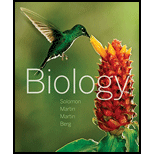
Concept explainers
During signal transduction (a) the cell converts an extracellular signal into an intracellular signal that leads to a change in some cell process (b) a signaling molecule directly activates or represses several genes (c) each enzyme catalyzes production of one molecule of product (d) enzymes in the signal cascade remain active until the last component of the pathway alters a cellular process (e) the signal is terminated by cyclic AMP
Introduction: There are four sequences of events that take place in cell signaling. These are signal transmission, reception, signal transduction, and response. In signal transduction, the cell changes the extracellular signals into intracellular signals. Cell generates a number of internal molecules that work in a specific manner.
Answer to Problem 1TYU
Correct answer: Signal transduction is a process in which extracellular signals get converted into intracellular signals. Hence the correct answer is option (a).
Explanation of Solution
Reason for the correct answer:
Option (a) is given as “the cell converts an extracellular signal into an intracellular signal that leads to a change in some cell process”. In signal transduction, the cell changes the received extracellular signals into intracellular signals. Cell generates a number of internal molecules that work in a specific manner to cause a response. It may either activates genes or deactivate it.
Hence the correct answer is option (a).
Reasons for incorrect answers:
Option (b) is given as, “a signaling molecule directly activates or represses several genes”. A signaling molecule activates several downstream molecules which either activate or deactivates the genes. This is not part of signal transduction event. Hence, option (b) is incorrect.
Option (c) is given as, “each enzyme catalyzes production of one molecule of product”. The signal get amplified at each downstream of the pathway in which an enzyme catalyzes several other molecules. This is not part of signal transduction event. Hence, option (c) is incorrect.
Option (d) is given as, “enzymes in the signal cascade remain active until the last component of the pathway alters a cellular process”. Enzyme in the signal cascade gets inactivated once it activates the downstream molecules. It does not remain active until the last component for the pathway alters the process. This is not part of signal transduction event. Hence, option (d) is incorrect.
Option (e) is given as, “the signal is terminated by cyclic AMP”. Cyclic AMP is an effector molecule. It does not terminate the signal. The signal is terminated by phosphodiesterase which inactivates the cyclic AMP to AMP or phosphatase which inactivates the protein by removing phosphate group. This is not part of signal transduction event.
Hence, option (e) is incorrect.
Hence the options (b), (c), (d), and (e) are incorrect.
Signal transduction is a process in which extracellular signals get converted into intracellular signals which causes changes in cell processes.
Want to see more full solutions like this?
Chapter 6 Solutions
Biology (MindTap Course List)
- Explain how the hormones of the glands listed below travel around the body to target organs and tissues : Pituitary gland Hypothalamus Thyroid Parathyroid Adrenal Pineal Pancreas(islets of langerhans) Gonads (testes and ovaries) Placentaarrow_forwardWhat are the functions of the hormones produced in the glands listed below: Pituitary gland Hypothalamus Thyroid Parathyroid Adrenal Pineal Pancreas(islets of langerhans) Gonads (testes and ovaries) Placentaarrow_forwardDescribe the hormones produced in the glands listed below: Pituitary gland Hypothalamus Thyroid Parathyroid Adrenal Pineal Pancreas(islets of langerhans) Gonads (testes and ovaries) Placentaarrow_forward
- Please help me calculate drug dosage from the following information: Patient weight: 35 pounds, so 15.9 kilograms (got this by dividing 35 pounds by 2.2 kilograms) Drug dose: 0.05mg/kg Drug concentration: 2mg/mLarrow_forwardA 25-year-old woman presents to the emergency department with a 2-day history of fever, chills, severe headache, and confusion. She recently returned from a trip to sub-Saharan Africa, where she did not take malaria prophylaxis. On examination, she is febrile (39.8°C/103.6°F) and hypotensive. Laboratory studies reveal hemoglobin of 8.0 g/dL, platelet count of 50,000/μL, and evidence of hemoglobinuria. A peripheral blood smear shows ring forms and banana-shaped gametocytes. Which of the following Plasmodium species is most likely responsible for her severe symptoms? A. Plasmodium vivax B. Plasmodium ovale C. Plasmodium malariae D. Plasmodium falciparumarrow_forwardStandard Concentration (caffeine) mg/L Absorbance Reading 10 0.322 20 0.697 40 1.535 60 2.520 80 3.100arrow_forward
- please draw in the answers, thank youarrow_forwarda. On this first grid, assume that the DNA and RNA templates are read left to right. DNA DNA mRNA codon tRNA anticodon polypeptide _strand strand C с A T G A U G C A TRP b. Now do this AGAIN assuming that the DNA and RNA templates are read right to left. DNA DNA strand strand C mRNA codon tRNA anticodon polypeptide 0 A T G A U G с A TRParrow_forwardplease answer all question below with the following answer choice, thank you!arrow_forward
 Biology (MindTap Course List)BiologyISBN:9781337392938Author:Eldra Solomon, Charles Martin, Diana W. Martin, Linda R. BergPublisher:Cengage Learning
Biology (MindTap Course List)BiologyISBN:9781337392938Author:Eldra Solomon, Charles Martin, Diana W. Martin, Linda R. BergPublisher:Cengage Learning Human Physiology: From Cells to Systems (MindTap ...BiologyISBN:9781285866932Author:Lauralee SherwoodPublisher:Cengage Learning
Human Physiology: From Cells to Systems (MindTap ...BiologyISBN:9781285866932Author:Lauralee SherwoodPublisher:Cengage Learning Human Biology (MindTap Course List)BiologyISBN:9781305112100Author:Cecie Starr, Beverly McMillanPublisher:Cengage Learning
Human Biology (MindTap Course List)BiologyISBN:9781305112100Author:Cecie Starr, Beverly McMillanPublisher:Cengage Learning Biology: The Dynamic Science (MindTap Course List)BiologyISBN:9781305389892Author:Peter J. Russell, Paul E. Hertz, Beverly McMillanPublisher:Cengage Learning
Biology: The Dynamic Science (MindTap Course List)BiologyISBN:9781305389892Author:Peter J. Russell, Paul E. Hertz, Beverly McMillanPublisher:Cengage Learning Biology 2eBiologyISBN:9781947172517Author:Matthew Douglas, Jung Choi, Mary Ann ClarkPublisher:OpenStax
Biology 2eBiologyISBN:9781947172517Author:Matthew Douglas, Jung Choi, Mary Ann ClarkPublisher:OpenStax BiochemistryBiochemistryISBN:9781305577206Author:Reginald H. Garrett, Charles M. GrishamPublisher:Cengage Learning
BiochemistryBiochemistryISBN:9781305577206Author:Reginald H. Garrett, Charles M. GrishamPublisher:Cengage Learning





